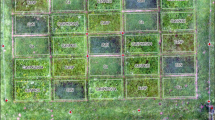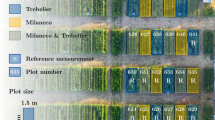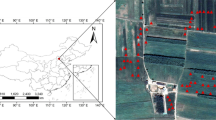Abstract
Estimating aboveground biomass is important for monitoring crop growth in agronomic field experiments. Often this estimation is done manually, destructively (mowing) or not (counting) on a relatively limited number of sub-plots within an experiment. In the presence of spatial heterogeneity in experiment fields, sensors developed for precision agriculture, have shown great potential to automate this estimation efficiently and provide a spatially continuous measurement over an entire plot. This study investigated the suitability of using an unmanned aerial vehicle (UAV) for biomass and yield estimations in an agronomic field experiment. The main objectives of this work were to compare the estimates made from manual field sampling with those made from UAV data and finally to calculate the improvement that can be expected from the use of UAVs. A 6-ha maize field was studied, with plot treatments for the study of the exogenous organic matter (EOM) amendment effect on crop development. 3D surface models were created from high resolution UAV RGB imagery, before crop emergence and during crop development. The difference between both surface models resulted in crop height which was evaluated against 38 reference points with an R2 of 0.9 and prediction error of 0.16 m. Regression models were used to predict above-ground biomass and grain yield (fresh or dry). Dried grain yield prediction with a generalized additive model gave an error of 0.8 t ha−1 calculated on 100 in-field validation measurements, corresponding to a relative error of 14.77%. UAV-based yield estimates from dry biomass were 15% more accurate than manual yield estimation.
















Similar content being viewed by others
References
Agisoft Metashape. (2019). Metashape presentation. Retrieved June 16, 2020, from https://www.agisoft.com/pdf/metashape_presentation.pdf.
Barnes, E. M., Sudduth, K. A., Hummel, J. W., Lesch, S. M., Corwin, D. L., Yang, C., et al. (2003). Remote- and ground-based sensor techniques to map soil properties. Photogrammetric Engineering & Remote Sensing, 69(6), 619–630. https://doi.org/10.14358/PERS.69.6.619
Bendig, J. V. (2015). Unmanned aerial vehicles (UAVs) for multi-temporal crop surface modelling. A new method for plant height and biomass estimation based on RGB imaging (Doctoral Thesis). University of Cologne, Faculty of Mathematics and Natural Sciences, Cologne.
Bendig, J., Bolten, A., Bennertz, S., Broscheit, J., Eichfuss, S., & Bareth, G. (2014). Estimating biomass of barley using crop surface models (CSMs) derived from UAV-Based RGB imaging. Remote Sensing, 6(11), 10395–10412. https://doi.org/10.3390/rs61110395
Bendig, J., Yu, K., Aasen, H., Bolten, A., Bennertz, S., Broscheit, J., et al. (2015). Combining UAV-based plant height from crop surface models, visible, and near infrared vegetation indices for biomass monitoring in barley. International Journal of Applied Earth Observation and Geoinformation, 39, 79–87. https://doi.org/10.1016/j.jag.2015.02.012
Castaldi, F., Pelosi, F., Pascucci, S., & Casa, R. (2017). Assessing the potential of images from unmanned aerial vehicles (UAV) to support herbicide patch spraying in maize. Precision Agriculture, 18(1), 76–94. https://doi.org/10.1007/s11119-016-9468-3
Catchpole, W. R., & Wheeler, C. J. (1992). Estimating plant biomass: A review of techniques. Australian Journal of Ecology, 17(2), 121–131. https://doi.org/10.1111/j.1442-9993.1992.tb00790.x
Chang, A., Jung, J., Maeda, M. M., & Landivar, J. (2017). Crop height monitoring with digital imagery from Unmanned Aerial System (UAS). Computers and Electronics in Agriculture, 141, 232–237. https://doi.org/10.1016/j.compag.2017.07.008
Duan, T., Chapman, S. C., Guo, Y., & Zheng, B. (2017). Dynamic monitoring of NDVI in wheat agronomy and breeding trials using an unmanned aerial vehicle. Field Crops Research, 210, 71–80. https://doi.org/10.1016/j.fcr.2017.05.025
Eisenbeiss, H. (2009). UAV photogrammetry (Doctoral Thesis). ETH Zurich, Switzerland.
Eitel, J. U. H., Höfle, B., Vierling, L. A., Abellán, A., Asner, G. P., Deems, J. S., et al. (2016). Beyond 3-D: The new spectrum of lidar applications for earth and ecological sciences. Remote Sensing of Environment, 186, 372–392. https://doi.org/10.1016/j.rse.2016.08.018
Ganguli, A. C., Vermeire, L. T., Mitchell, R. B., & Wallace, M. C. (2000). Comparison of four nondestructive techniques for estimating standing crop in shortgrass plains. Agronomy Journal, 92(6), 1211–1215. https://doi.org/10.2134/agronj2000.9261211x
Godwin, R. J., & Miller, P. C. H. (2003). A review of the technologies for mapping within-field variability. Biosystems Engineering, 84(4), 393–407. https://doi.org/10.1016/S1537-5110(02)00283-0
Hassan, M. A., Yang, M., Fu, L., Rasheed, A., Zheng, B., Xia, X., et al. (2019). Accuracy assessment of plant height using an unmanned aerial vehicle for quantitative genomic analysis in bread wheat. Plant Methods, 15, 37. https://doi.org/10.1186/s13007-019-0419-7
Hoffmeister, D., Bolten, A., Curdt, C., Waldhoff, G., & Bareth, G. (2010). High-resolution crop surface models (CSM) and crop volume models (CVM) on field level by terrestrial laser scanning. Proceedings SPIE 7840, sixth international symposium on digital earth: Models, algorithms, and virtual reality (Vol. 7840, p. 78400E). Bellingham, USA: SPIE. https://doi.org/10.1117/12.872315.
Holman, F. H., Riche, A. B., Michalski, A., Castle, M., Wooster, M. J., & Hawkesford, M. J. (2016). High throughput field phenotyping of wheat plant height and growth rate in field plot trials using UAV based remote sensing. Remote Sensing, 8(12), 1031. https://doi.org/10.3390/rs8121031
Hugenholtz, C. H., Whitehead, K., Brown, O. W., Barchyn, T. E., Moorman, B. J., LeClair, A., et al. (2013). Geomorphological mapping with a small unmanned aircraft system (sUAS): Feature detection and accuracy assessment of a photogrammetrically-derived digital terrain model. Geomorphology, 194, 16–24. https://doi.org/10.1016/j.geomorph.2013.03.023
Hunt, E. R., Hively, W. D., Fujikawa, S. J., Linden, D. S., Daughtry, C. S. T., & McCarty, G. W. (2010). Acquisition of NIR-green-blue digital photographs from unmanned aircraft for crop monitoring. Remote Sensing, 2(1), 290–305. https://doi.org/10.3390/rs2010290
IGN. (2016). Caméra légère IGN | IGN Lightweight Camera. Retrieved October 8, 2020, from https://www.ign.fr/institut/innovation/camera-legere-ign.
Inrae. (2019). QualiAgro. Retrieved October 8, 2020, from https://www6.inra.fr/qualiagro_eng.
Johnson, L. F., Herwitz, S., Dunagan, S., Lobitz, B., Sullivan, D., & Slye, R. (2003). Collection of ultra high spatial and spectral resolution image data over california vineyards with a small UAV. In Proceedings of the 30th international symposium on remote sensing of environment (pp. 10–14). Columbia, USA: ICRSE.
Kraus, K., & Waldhäusl, P. (1998). Manuel de photogrammétrie: Principes et procédés fondamentaux (photogrammetry manual: Basic principles and processes). Paris, France: Hermès.
Li, W., Niu, Z., Chen, H., Li, D., Wu, M., & Zhao, W. (2016). Remote estimation of canopy height and aboveground biomass of maize using high-resolution stereo images from a low-cost unmanned aerial vehicle system. Ecological Indicators, 67, 637–648. https://doi.org/10.1016/j.ecolind.2016.03.036
Lindblom, J., Lundström, C., Ljung, M., & Jonsson, A. (2017). Promoting sustainable intensification in precision agriculture: Review of decision support systems development and strategies. Precision Agriculture, 18(3), 309–331. https://doi.org/10.1007/s11119-016-9491-4
Liu, S., Baret, F., Abichou, M., Boudon, F., Thomas, S., Zhao, K., et al. (2017). Estimating wheat green area index from ground-based LiDAR measurement using a 3D canopy structure model. Agricultural and Forest Meteorology, 247, 12–20. https://doi.org/10.1016/j.agrformet.2017.07.007
Lowe, D. G. (2004). Distinctive image features from scale-invariant keypoints. International Journal of Computer Vision, 60(2), 91–110. https://doi.org/10.1023/B:VISI.0000029664.99615.94
Mulla, D. J. (2013). Twenty five years of remote sensing in precision agriculture: Key advances and remaining knowledge gaps. Biosystems Engineering, 114(4), 358–371. https://doi.org/10.1016/j.biosystemseng.2012.08.009
Noirot-Cosson, P. E., Vaudour, E., Gilliot, J. M., Gabrielle, B., & Houot, S. (2016). Modelling the long-term effect of urban waste compost applications on carbon and nitrogen dynamics in temperate cropland. Soil Biology and Biochemistry, 94, 138–153. https://doi.org/10.1016/j.soilbio.2015.11.014
Phase One. (2018). Phase One IXM cameras. Retrieved October 8, 2020, from https://industrial.phaseone.com/iXM_Camera_Series.aspx.
Pinter, P. J., Jr., Hatfield, J. L., Schepers, J. S., Barnes, E. M., Moran, M. S., Daughtry, C. S. T., et al. (2003). Remote sensing for crop management. Photogrammetric Engineering & Remote Sensing, 69(6), 647–664. https://doi.org/10.14358/PERS.69.6.647
Poblete-Echeverría, C., Olmedo, G. F., Ingram, B., & Bardeen, M. (2017). Detection and segmentation of vine canopy in ultra-high spatial resolution RGB imagery obtained from unmanned aerial vehicle (UAV): A case study in a commercial vineyard. Remote Sensing, 9(3), 268. https://doi.org/10.3390/rs9030268
R Development Core Team. (2016). R: The R project for statistical computing. Retrieved Ocober 8, 2020, from https://www.r-project.org/.
senseFly - eMotion. (2020). senseFly eMotion. Retrieved June 16, 2020, from https://www.sensefly.com/software/emotion.
Sun, S., Li, C., & Paterson, A. H. (2017). In-field high-throughput phenotyping of cotton plant height using LiDAR. Remote Sensing, 9(4), 377. https://doi.org/10.3390/rs9040377
Ullman, S. (1979). The interpretation of structure from motion. Proceedings of the Royal Society of London B Biological Sciences, 203(1153), 405–426. https://doi.org/10.1098/rspb.1979.0006
Verger, A., Vigneau, N., Chéron, C., Gilliot, J. M., Comar, A., & Baret, F. (2014). Green area index from an unmanned aerial system over wheat and rapeseed crops. Remote Sensing of Environment, 152, 654–664. https://doi.org/10.1016/j.rse.2014.06.006
Wood, S. (2017). Package ‘mgcv.’. Retrieved June 16, 2020, from https://cran.r-project.org/web/packages/mgcv/mgcv.pdf.
Yue, J., Yang, G., Li, C., Li, Z., Wang, Y., Feng, H., et al. (2017). Estimation of winter wheat above-ground biomass using unmanned aerial vehicle-based snapshot hyperspectral sensor and crop height improved models. Remote Sensing, 9(7), 708. https://doi.org/10.3390/rs9070708
Zhang, C., & Kovacs, J. M. (2012). The application of small unmanned aerial systems for precision agriculture: A review. Precision Agriculture, 13(6), 693–712. https://doi.org/10.1007/s11119-012-9274-5
Zhang, N., Wang, M., & Wang, N. (2002). Precision agriculture—a worldwide overview. Computers and Electronics in Agriculture, 36(2), 113–132. https://doi.org/10.1016/S0168-1699(02)00096-0
Zhou, X., Zheng, H. B., Xu, X. Q., He, J. Y., Ge, X. K., Yao, X., et al. (2017). Predicting grain yield in rice using multi-temporal vegetation indices from UAV-based multispectral and digital imagery. ISPRS Journal of Photogrammetry and Remote Sensing, 130, 246–255. https://doi.org/10.1016/j.isprsjprs.2017.05.003
Acknowledgements
The authors are grateful to Jean-Noel Rampon and Vincent Mercier, in charge in 2014 of the daily management of the field experiment, for the maize sampling and analysis.
Funding
This publication benefited from financial support from the scientific direction of AgroParisTech and from the French national observatory networks “SOERE PRO” part of the AnaEE-France project of the French Investments for the Future (Investissements d'Avenir) program, implemented by the French National Research Agency (ANR) (ANR-11-INBS-0001). The field experiment QualiAgro has been managed since 1998 within a cooperation between INRAE and Veolia Research and Innovation.
Author information
Authors and Affiliations
Contributions
SH and JMG designed the experiments. Experiments were performed by JMG, JM and DH. JMG drafted the manuscript with help and contributions from all other authors. Analyses, figures and tables were mainly performed and produced by JMG. All authors read and approved the final manuscript.
Corresponding author
Ethics declarations
Conflict of interest
The authors declare that they have no conflict of interest.
Additional information
Publisher's Note
Springer Nature remains neutral with regard to jurisdictional claims in published maps and institutional affiliations.
Rights and permissions
About this article
Cite this article
Gilliot, J.M., Michelin, J., Hadjard, D. et al. An accurate method for predicting spatial variability of maize yield from UAV-based plant height estimation: a tool for monitoring agronomic field experiments. Precision Agric 22, 897–921 (2021). https://doi.org/10.1007/s11119-020-09764-w
Accepted:
Published:
Issue Date:
DOI: https://doi.org/10.1007/s11119-020-09764-w




